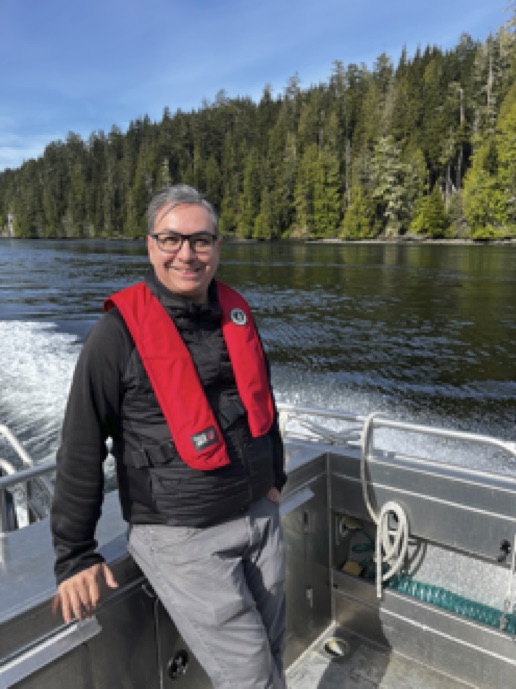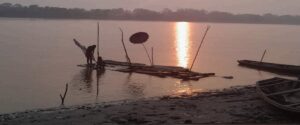Ciência & Cultura — What is Ocean Networks Canada?
Pieter Romer — Ocean Networks Canada (ONC) is an ocean data and technology powerhouse that specializes in cabled observatories, which collect ocean data with instruments that can relay their data to the shore in real-time over fibre-optic cables. We call it the Internet-connected ocean. Our largest Observatory is NEPTUNE, which is 800 km long off the west coast of Vancouver Island. The majority of our observatories are in First Nation territories of British Columbia. We have a community observatory with the Gitga’at, Tsleil-Waututh and Inuit in the Arctic as well as an observatory on the east coast of Canada. 12, 000 sensors provide globally accessible live information on how the ocean is changing in real-time 24/7 365 days in the year which is available over the Internet to anybody in the world. We monitor everything that is possible in the ocean, even neutrinos from space! (Figure 1)

Figure 1. One of the world’s leading ocean research facilities, ONC collects essential data and promotes citizen science, education and partnerships with Indigenous communities.
(Photo: Personal archive. Reproduction)
C&C — What is the importance of ONC Indigenous partnerships? How many of them are there, and some topics in which these partnerships work?
PR — Our goal is to make ocean data accessible, relevant, and useful to coastal and Indigenous communities. Ongoing collaborations inform program development, long and short-term projects, training and workshops, infrastructure support, and data products. Coastal communities are the knowledge keepers and stewards of their marine territories. Indigenous communities have seen the changes since time immemorial and know the challenges their environments are facing. In another partnership program, Community Fishers, community members receive training in collecting water column data and work with ONC to establish a sampling plan in their area of interest. The community-led design of the Community Fishers Program recognizes the immense value of Indigenous knowledge and pairs it with oceanographic instruments, training, and scientific support. This means that the high-quality data being collected are relevant to the local research interests as well as contribute to wider ocean science knowledge. A fundamental feature of Community Fishers partnerships is data ownership, control, and data attribution by the communities conducting the research. In our Community Fishers monitoring program, we currently partner with 13 Indigenous communities, and this number is growing all the time. In total, we currently have 37 Indigenous partnerships in various capacities in education and monitoring. This fluctuates on a project-by-project basis. Some projects are very in-depth, while others are in a supportive role. (Figure 2)
“It recognizes the immense value of Indigenous knowledge and pairs it with oceanographic instruments, training, and scientific support.”
C&C — Can you provide one or two examples in which these partnerships were essential to obtaining quality results?
PR — All our partnerships are essential, but one partnership that stands out is that we recently did a Tsunami Risk Assessment of the Northwest Coast of Vancouver Island, where we worked with five First Nations: Quatsino First Nation and four Nuu-chah-nulth First Nations. We flew over their communities with Lidar to understand the impact zones if a Tsunami were to occur, and we developed DEM’s or Digital Elevation Models to understand current velocities. Our Indigenous Engagement team did research and pre-interviews with knowledge holders and held advisory group meetings to understand the “boots on the ground” scenarios as far back as 1700 to the 1964 Tsunami and present. What we learned is that the traditional knowledge aligned with our data and vice versa. If we didn’t work with the Indigenous communities, we wouldn’t have the complete data and fully understand how the waves and surges interacted with the communities. This would have been a missed opportunity, and the study would have been flat. As part of that project and based on the research the Indigenous engagement team conducted, and to give back to the communities who shared their knowledge with us, we produced a half hour documentary on the Indigenous history of Tsunamis on the west coast of Vancouver Island. Another project we just completed is the WSÁNEĆ Ocean Knowledge Cards, which are a deck of education cards, that kids and adults can use to learn about the ocean species and the traditional knowledge on how WSÁNEĆ First Nations used those species for food and tools, along with Indigenous language for the species. There are also many examples with our Community Fishers monitoring program, where we collaborate with 13 Indigenous communities. (Figure 2)

Figure 2. Integrating indigenous knowledge with advanced technologies expands understanding of marine ecosystems and strengthens coastal communities.
(Photo: Personal archive. Reproduction)
C&C — Integration of scientific and Indigenous knowledge presents many challenges. Can you give examples of approaches that are being used by these joint projects to overcome such challenges?
PR — I don’t see them as challenges, I see them as opportunities. The best way to build a true and meaningful partnership is from the proposal up, as a team. This way, everyone is on the same page and the communication is clear. But projects vary in their capacity, and not all projects start from a proposal. Engaging early and meaningfully with Indigenous peoples is key to a successful partnership and project.
C&C — Are all such research collaborations initiated by ONC, or are there cases in which research collaborations are prompted by indigenous partners?
PR — No, not all our partnerships with Indigenous communities are initiated by ONC. Often an Indigenous community receives federal funding, and they engage us for a monitoring sensor, software, and training.
“What we learned is that the traditional knowledge aligned with our data and vice versa. If we didn’t work with the Indigenous communities, we wouldn’t have the complete data.”
C&C — Are you involved in CARE? Can you tell us a little about initiatives that are based on/influenced by CARE principles?
PR — We incorporate FAIR and CARE principles into our data management agreements. Indigenous communities instantly benefit from the data for their own guardianship, fisheries, or stewardship. They also have control over their data, for instance they can turn off a public censor in our data management system Oceans 3.0. They can also request to change the agreement anytime.
“The best way to build a true and meaningful partnership is from the proposal up, as a team.”









